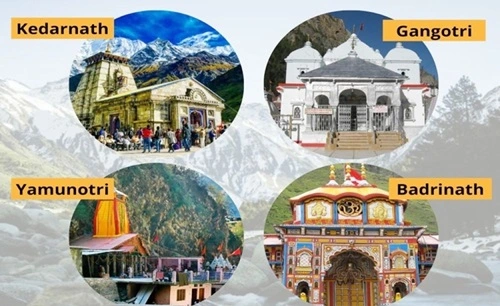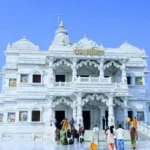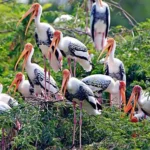Char Dham, meaning “Four Abodes,” is one of the most revered pilgrimage circuits in India, comprising four holy shrines: Yamunotri, Gangotri, Kedarnath, and Badrinath. Located in the Garhwal region of Uttarakhand, these temples hold deep religious significance, attracting millions of pilgrims each year. Embarking on the Char Dham Yatra, as the pilgrimage is called, is considered a spiritually transformative journey that purifies the soul and brings divine blessings.
Situated in the high Himalayas, the Char Dham temples remain open only for a limited period each year due to extreme weather conditions. Choosing the right time to visit can ensure a safe and fulfilling pilgrimage. Here’s a guide to help you plan the best time for your Char Dham Yatra, based on seasonal variations and the spiritual ambiance.

Late April to Early July: The Spring and Summer Season
Temperature Range: 5°C to 25°C
Why Visit? Clear weather, pleasant temperatures, ideal for scenic views and comfortable travel
The Char Dham temples typically open to pilgrims in late April or early May, around the time of Akshaya Tritiya, which is considered an auspicious day in Hinduism. This marks the beginning of the Char Dham Yatra season, and the weather is relatively mild and clear, with temperatures ranging from 5°C in the higher altitudes to around 25°C in the lower regions. The spring and summer months are considered one of the best times to visit Char Dham, especially for those who prefer comfortable travel conditions.
In May and June, the roads to the Char Dham sites are clear of snow, making the journey smoother. The pleasant temperatures and blooming flora enhance the pilgrimage experience, allowing visitors to enjoy the beauty of the surrounding mountains, rivers, and valleys. The trekking routes to Kedarnath, which involve a 16-kilometer trek, are easier to navigate, with minimal risk of slippery paths or extreme cold.
This period also sees a high influx of pilgrims, especially on significant Hindu festivals like Buddha Purnima and Ganga Dussehra. While the crowds can be large, the vibrant energy and devotion create a unique atmosphere that enhances the sense of spiritual fulfillment. However, it’s advisable to book accommodations and transport in advance due to the high demand during peak season.
July to September: The Monsoon Season and the Beauty of the Rain
Temperature Range: 10°C to 20°C
Why Visit? Lush green landscapes, quieter paths, ideal for solitude seekers
From July to September, the Char Dham region experiences monsoon rains, which can be heavy and unpredictable. During these months, temperatures generally remain between 10°C and 20°C. While the rains bring a lush green transformation to the mountains, the monsoon season is not the most popular time for the pilgrimage due to challenging travel conditions.
Heavy rainfall often leads to landslides and road blockages, making some routes treacherous and difficult to navigate. However, the monsoon season also offers a quieter experience for pilgrims who don’t mind the rains and are seeking solitude in their spiritual journey. The crowds are significantly reduced during monsoon, allowing for a peaceful and introspective pilgrimage.
The rain-washed surroundings and mist-covered hills add a mystical touch to the experience. The rivers are at their fullest, and waterfalls cascade down the mountains, creating stunning scenery. Pilgrims who visit during monsoon should exercise caution, keep track of weather updates, and prepare for travel delays. Proper rain gear and a flexible schedule are essential for those undertaking the Char Dham Yatra in these months.
Late September to Early November: The Post-Monsoon and Autumn Season
Temperature Range: 5°C to 15°C
Why Visit? Clear skies, crisp weather, lower crowds, ideal for photography
The period from late September to early November is another excellent time to visit Char Dham, particularly for those who prefer fewer crowds and clear weather. Following the monsoon rains, the landscapes are lush and vibrant, while the air is crisp, offering breathtaking views of the Himalayas against clear blue skies. The temperature ranges from a chilly 5°C in the higher elevations to around 15°C in lower areas, creating comfortable conditions for both travel and trekking.
The post-monsoon season is ideal for photography, as the mountains, valleys, and rivers are at their scenic best. The rivers and streams flow gently, and the pathways are firm, making the journey to each shrine more enjoyable. The trek to Kedarnath, in particular, is manageable and rewarding with panoramic views of snow-capped peaks.
This season is also suitable for pilgrims who prefer a quieter experience without the peak season rush. Many devotees find the autumn months ideal for a peaceful pilgrimage, taking advantage of the serene ambiance to connect with nature and spirituality. The Char Dham temples typically close by the end of October or early November, around Diwali, when winter begins to set in and the paths become inaccessible due to snowfall.
Planning Tips for the Char Dham Yatra
A successful Char Dham Yatra requires proper planning and preparation. Here are some key tips to make the journey safer and more fulfilling:
- Weather and Road Conditions: Check the weather forecast and road conditions before embarking on your journey. Unexpected changes in weather, especially during monsoon and late autumn, can affect travel plans, so keeping a flexible itinerary can be helpful.
- Physical Fitness: The Char Dham Yatra involves trekking and walking at high altitudes, particularly to Kedarnath, which can be physically demanding. Pilgrims are advised to engage in some physical preparation before the journey to build stamina and acclimate to higher altitudes.
- Advance Bookings: Due to the high demand during peak season, it’s essential to book accommodations, transport, and helicopter services (if needed) well in advance. Many travelers opt for helicopter services to Kedarnath, which can ease the journey for those who may find trekking challenging.
- Clothing and Essentials: Regardless of the season, carry warm clothing, as temperatures in the mountains can drop suddenly, especially in the evenings. Sturdy walking shoes, rain gear (if visiting during monsoon), sunscreen, and a first-aid kit are essential. Keeping some high-energy snacks and water on hand is also advisable.
- Guided Tours: For those who prefer organized travel, guided tours and packages for the Char Dham Yatra are widely available. These packages typically include accommodations, meals, and local guides, making the journey more comfortable and stress-free.
- Spiritual Etiquette: Char Dham is a sacred pilgrimage for Hindus, so maintaining respect for local customs and traditions is important. Dress modestly, avoid littering, and refrain from loud behavior within temple premises to preserve the sanctity of the shrines.
Conclusion
The Char Dham Yatra is more than just a pilgrimage; it’s a journey that blends spirituality, adventure, and the serene beauty of the Himalayas. While the summer months offer a vibrant atmosphere and the monsoon season brings lush landscapes, autumn provides the perfect balance of tranquility and scenic splendor.
Whether you’re drawn by devotion, the allure of the Himalayas, or a quest for inner peace, Char Dham promises an experience that resonates deeply with every visitor. Embracing both the challenges and rewards of this sacred journey can leave one with a profound sense of fulfillment and connection to India’s spiritual heritage.


